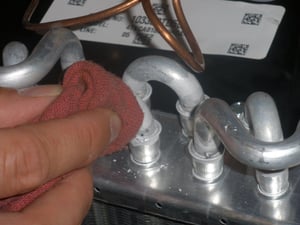Having clean base materials is one of the Six Fundamentals of Brazing that ensure quality braze joints:
1. Good fit and proper clearance
2. Clean base materials
3. Proper flux/atmosphere
4. Proper fixturing
5. Proper heating
6. Final cleaning

Why Clean Base Materials?
Make sure your base materials are clean and free of dirt or debris because contaminants can interfere with the metal-to-metal bond necessary for a strong joint. Residual machining oil, protective coatings, oxidation, grime and embedded aluminum oxide from abrasive media are some examples of contaminants that can be detrimental to brazing. These contaminants can prevent vital capillary action in a braze joint, leaving behind large voids and decreasing strength, which may cause the joint to leak or fail prematurely.
Remember, even though you may use flux in your brazing application, it is not the duty of flux to clean the base materials. Flux is designed to remove residual oxides and protect the joint area from oxidation during brazing.
How to Prepare the Surface
Remove any oil or grease by degreasing or washing. If you are using a machining oil on parts to be brazed, ask your lubricant supplier whether it is a mineral-based or water-soluble lubricant – this will determine which type of cleaning method they recommend. A simple test for material cleanliness is to use a white tissue or white glove to check for residue.
Remove oxidation by either chemical or mechanical means (e.g. acid cleaning, wire brush). Using non-metallics, such as aluminum oxide or silicon dioxide (glass), can cause wetting issues in brazing. Therefore, whenever possible, use metallic materials for mechanical cleaning. An example would be using metallic media in a media blaster rather than aluminum oxide grit or glass beads. Dedicate your cleaning equipment to your chosen method to prevent the possibility of contamination.
The Impact of Surface Finish
The surface finish of your parts is also important to brazing. The typical surface finish should be between 24-64 µin. If your parts are too rough (>250 µin), such as in a cast material, the material’s pores may absorb the brazing filler metal and make it difficult to properly fill the joint. If your finish is too smooth (<30 µin), such as a highly polished surface, you may incur wetting issues due to a lack of capillary paths in the material. A machined or milled finish is acceptable for most applications. Remember that some surface roughness helps form capillary paths for the filler metal to flow into the braze joint.
Properly cleaning and preparing your base materials helps ensure a strong braze joint. Any contaminants can cause voids which impact the strength and reliability of your braze joint. Remember that a machined or milled finish is typically ideal for brazing; a surface that is too rough or too smooth can impede capillary action.
See the Brazing Book on our website for more information on the Six Fundamentals of Brazing.
We are pleased to provide expert information for Global Brazing Solutions® through our blogs and instructional videos. Feel free to share this posting with associates, and save our blog site to your Favorites.
Questions? Contact us for further assistance. For detailed questions, call the Lucas-Milhaupt Technical Services Department at 800.558.3856.
Reference: AWS Brazing Handbook, Fifth Edition, 2007.
Disclaimer: Lucas-Milhaupt, Inc. believes the information contained herein to be reliable. However, Lucas-Milhaupt gives the technical information without charge, and the user shall use such information at its own discretion and risk.

